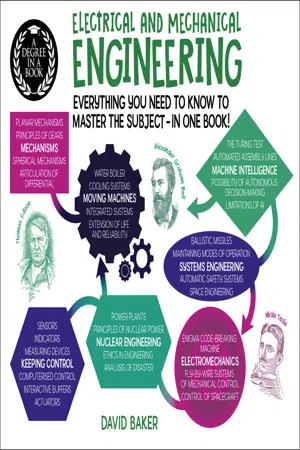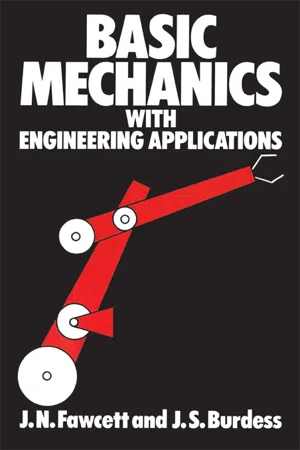Application of Newton's Second Law
The application of Newton's Second Law involves using the formula F = ma to calculate the force acting on an object. This law states that the acceleration of an object is directly proportional to the net force acting on it and inversely proportional to its mass. It is widely used to analyze the motion of objects and understand the forces acting on them.
8 Key excerpts on "Application of Newton's Second Law"
- eBook - ePub
A Degree in a Book: Electrical And Mechanical Engineering
Everything You Need to Know to Master the Subject - in One Book!
- David Baker(Author)
- 2021(Publication Date)
- Arcturus(Publisher)
...That force can be generated by internally or externally applied force. For instance, if a satellite has a rocket motor capable of applying a force, either to speed it up or slow it down, and that force is applied, it will change the motion of the satellite. Should that satellite run into transient chemical molecules, such as might be encountered at the fringes of the atmosphere, it will slow down through friction. Newton’s second law of motion – acceleration The second law stipulates that the rate of change in the momentum of a body is directly proportional to the force applied. But this is only so for bodies of constant mass, and in this context a net force is equal to the rate of change of the momentum. This defines the conservation of momentum, and any variation in the mass of the object will cause a change in momentum that is not the result of an external force. The way Newton described this law was typical of the expressions of the day. Today, the law is expressed as: the change in momentum of a body is proportional to the impulse impressed on the body and occurs along the straight line upon which the impulse is discharged. Second law formula Assuming that the mass (m) is unchanging, Newton’s second law is written as F = ma, showing that force (F) equals mass times acceleration (a). It follows that if no acceleration is applied to the body, no net force is acting upon it. Newton’s third law of motion – equal and opposite The third law states that forces between two objects are of equal magnitude and opposite direction. This binds forces as being interactive between bodies, or in different elements of a finite body, so that there is no condition in which there is no reciprocal action and reaction. This is probably the most intuitive law in that it defines the way two surfaces relate to each other. For instance, when an aircraft is taking off, the wheel tyres push against the runway and the runway pushes against the tyres...
- eBook - ePub
- Alan Hendrickson(Author)
- 2012(Publication Date)
- Routledge(Publisher)
...Stated here without the full mathematical rigor they would receive in a physics text, they are: 1. If a mass is stationary it will remain stationary, or if a mass is moving with a constant velocity it will continue to do so, until any net force acts on the mass. Put another way, velocity will not change unless a force is present to make the change. When a net force exists on an object, a force in excess of those needed to overcome friction and to provide whatever lifting force is needed to counteract gravity, then that object will accelerate. The exact amount of acceleration obtained for a given force is spelled out in Newton’s second law: 2. When a force acts on a mass, that mass will accelerate in the direction of the force. The magnitude of the acceleration will be directly related to the magnitude of the force, and inversely related to the magnitude of the mass. Mathematically: F a c c e l = m a Where F accel = the force needed to accelerate a mass (lb, N) m = mass of the material upon which the force acts (slug, kg) a = acceleration of the mass (ft/sec 2, m/sec 2) This simple formula defines the force needed to accelerate a given mass, and defines the first of the three force components summed in the maximum power formula. Before the implications of this law are discussed at length though, Newton’s third law is: 3. A force can exist only as one of an equal in magnitude but oppositely directed pair of forces. Traditionally this is worded as “action equals reaction.” This law is not stated as one formula, but rather it is a basic assumption that was used in developing the whole branch of physics called mechanics that itself encompasses the mechanical engineering topics of static structures and machine design. Mass and Force Newton’s second law now allows a discussion of the third fundamental, mass or force...
- eBook - ePub
- W. Bolton(Author)
- 2015(Publication Date)
- Routledge(Publisher)
...Thus an alternative way of expressing the law is: The acceleration of a body is proportional to the applied external force and takes place in the direction of action of that force. This law thus enables us to calculate the force needed to change the momentum of a body and to accelerate it. Law 3 If one body exerts a force on a second body then the second body exerts an equal and opposite force on the first, i.e. to every action there is an opposite and equal reaction. Thus if a gun fires bullets in one direction, i.e. exerts a force on them to propel them in that direction, the gun will experience a recoil force which is equal in size but in the opposite direction to the force propelling the bullets out of the gun. The mass of a body is a measure of the quantity of matter it contains. As the equation F = ma indicates, it can also be considered to be the quantity which determines the measure of the resistance of a body to be accelerated by a force; the more mass a body has the greater the force needed to give it a particular acceleration and so the greater inertia it has. The weight of a body at rest at the earth’s surface is equal to the gravitational force the earth exerts on it. If we allow a body to freely fall it will accelerate at the acceleration due to gravity g under the action of the gravitational force. Thus, using force = ma: weight = mass × acceleration due to gravity When an object of mass m is at rest on a horizontal surface there can be no resultant force acting on it (Newton’s first law). Thus the weight mg of the object, which acts at right angles to the horizontal surface, must be balanced by some reaction force N which is at right angles, i.e. normal, to the surface and acting on the mass (Figure 6.1). Thus: N = mg If the object is resting on an inclined plane the reaction force is normal to the surface and must be equal to the component of the weight which is at right angles to the surface (Figure 6.2)...
- eBook - ePub
Beyond the 80/20 Principle
The Science of Success from Game Theory to the Tipping Point
- Richard Koch(Author)
- 2020(Publication Date)
- Nicholas Brealey Publishing(Publisher)
...This is a restatement of Galileo’s law of inertia, that bodies remain at rest or in constant motion, except when moved by an outside disturbance. The second law is that force (F) is directly proportional to the change in momentum that it generates. Twice as much force will cause twice as much change in an object’s momentum. Newton provided an original definition of momentum—mass times velocity—where mass (m) is the ‘quantity of matter’ in an object. Change in velocity is the same as acceleration (a). Hence Newton derives his famous formula: F = ma (force equals mass times acceleration). The third law of motion, Newton’s most original insight, is that every action produces an equal and opposite reaction. If similar objects collide, they bounce off with equal force. If an object’s motion is disturbed (its momentum changes), then the motion of another object must also be disturbed so that the ‘aggregate’ momentum is unchanged. The second disturbance must be precisely equal to the first, but in an opposite direction. From these three laws, and Galileo’s law of uniform acceleration, Newton arrived at the concept of gravity. An object falls to the ground and its momentum increases. Newton’s three laws say that some force must be responsible for acceleration, and this force must be constant if (as Galileo showed) acceleration was constant. This force must therefore be gravity. He concluded that the force of gravity on an object is constant and directly proportional to the mass of the object. Hence Newton’s law of gravity (also known as his ‘inverse square rule’) that between any two bodies, the gravitational force is proportional to the product of their masses, and inversely proportional to the square of the distance between them. The most important external force, whether on earth or in the sky, is gravity...
- eBook - ePub
- J Jones, J Burdess, J Fawcett(Authors)
- 2012(Publication Date)
- Routledge(Publisher)
...2 Newton’s laws of motion 2.1 Laws of Motion Having studied the geometric properties of motion we now need to consider the forces necessary to produce motion, and the behaviour of bodies when forces are applied to them. The relationship between force and motion was formulated by Sir Isaac Newton (1642-1727). His results were first published in his Principia (1687). Newton’s laws of motion may be expressed as follows. Law 1 The absolute velocity ν of a particle * remains constant if there is no net external force applied to the particle. Note that ν is a vector so that both magnitude and direction will be constant. Law 2 When a force F acts on a particle the absolute acceleration of the particle is directly proportional to the magnitude of the force and is in the direction of the force. Law 3 When two particles A and B are in contact the force applied to particle A by particle B, at the contact point, is equal in magnitude but opposite in direction from the force applied to particle B by particle A. It should be noted that the First Law is a special case of the Second Law since it represents the condition when the acceleration of the particle is zero. The Second Law may be formulated mathematically as where F is the force applied to the particle, m is the mass of the particle, and a is the acceleration of the particle. k is a constant of proportionality. If more than one force acts on the particle, F is equal to the vector sum of all of the individual forces. The acceleration vector will always be in the same direction as the resultant force vector. Laws 1 and 2 apply only to motion relative to frames of reference which are either stationary or translating with constant velocity. Such frames are called inertial frames of reference and the acceleration measured in such a frame is always the absolute acceleration of the particle...
- eBook - ePub
The Really Useful Science Book
A Framework of Knowledge for Primary Teachers
- Steve Farrow, Amy Strachan(Authors)
- 2017(Publication Date)
- Routledge(Publisher)
...This relationship can be summarized as: force is proportional to mass, or F (is proportional to) m (2) This can also be investigated with a sand tray, but this time with spheres of similar size but different masses being dropped – for example, a pea, a marble, a ball bearing – into the sand, from the same height. Again, the larger ‘craters’ left by spheres of larger mass should confirm the effect. The two effects described in equations (1) and (2) can be combined as: Force = mass × acceleration, or (F = ma) (3) Conversely, if the force acting on an object remains constant, the acceleration of the object produced by the force will be inversely proportional to the mass of the object. In other words, if the mass of the object doubles, the acceleration will be halved, providing the force remains constant. In the trolley experiment shown above, the second law predicts that, if the mass of the trolley was 100 g, and it moved 1 m along the ramp in the first second of travel, an increase in the mass of the trolley to 200 g would result in it travelling only 0.5 m in the first second, under the effect of the same force: when the mass doubles, the acceleration is halved. So, acceleration is inversely proportional to mass, or: (4) And, as F (is proportional to) a (from equation (1), above): (5) CONCEPT CONFUSION Children often think that, for something to be moving, one force has to be bigger than another. However, it is important to highlight that, when an object is moving steadily, or not at all, the forces are balanced. If forces are unbalanced (one force is bigger than the opposing force), acceleration or deceleration will occur. Gravity This last equation can also be exemplified by a consideration of objects falling – being pulled towards the Earth – under the effect of gravity. All finite objects are made of matter, and the amount of matter in an object is known as its mass, measured in grams...
- eBook - ePub
- Colin Salter(Author)
- 2021(Publication Date)
- Pavilion(Publisher)
...Isaac Newton (1642–1727) Laws of motion The apple tree still grows from which Isaac Newton’s apple famously fell, at the scientist’s home, Woolsthorpe Manor in Lincolnshire. Newton intuitively saw gravity at work and set about defining the forces acting on the fruit. In doing so he laid the foundations of classical mechanics. N ewton’s three-volume masterwork Philosophiæ Naturalis Principia Mathematica, published in 1657, is regarded as one of the most important books in the history of science. The Mathematical Principles of Natural Philosophy (to give it its translated title) contained the first publication of his three Laws of Motion. They transformed our understanding of everyday movement and made Newtonian physics the dominant model until the emergence of Einstein’s Theory of Relativity two hundred years later. Put simply, the First Law states that if an object is at rest (not moving) it will remain at rest unless a force makes it move; and if an object is moving, it will continue to move unless a force stops it. The Second Law says that the harder the force which pushes or pulls an object, the further and faster it will move. The Third Law is perhaps the best known, that for every action (or force) there is an equal and opposite reaction. This is the law illustrated by that perennial desktop toy Newton’s Cradle. Principia also contained Newton’s Law of Universal Gravitation. It describes the force of gravity which exists between any two particles in the universe, and mathematically defines it in terms of their masses and the distance between them. It became known as the First Great Unification because it tied together everything that was known about both gravity and astronomical movement. Such events in scientific history are not as common as you might expect – the Second Great Unification was James Clerk Maxwell’s study of electromagnetism in the 1860s; the Third was Albert Einstein’s early-twentieth-century unification of space and time, and of mass and energy...
- eBook - ePub
Newton's Philosophy of Nature
Selections from His Writings
- Sir Isaac Newton, H. S. Thayer, H. S. Thayer(Authors)
- 2012(Publication Date)
- Dover Publications(Publisher)
...But to treat of mechanics is not my present business. I was aiming only to show by those examples the great extent and certainty of the Third Law of Motion. For if we estimate the action of the agent from the product of its force and velocity, and likewise the reaction of the impediment from the product of the velocities of its several parts, and the forces of resistance arising from the friction, cohesion, weight, and acceleration of those parts, the action and reaction in the use of all sorts of machines will be found always equal to one another. And so far as the action is propagated by the intervening instruments, and at last impressed upon the resisting body, the ultimate action will be always contrary to the reaction. PROPOSITION LXIX, THEOREM XXIX 11 In a system of several bodies A, B, C, D, etc., if any one of those bodies, as A, attract all the rest, B, C, D, etc., with accelerative forces that are inversely as the squares of the distances from the attracting body, and another body, as B, attracts also the rest, A, C, D, etc., with forces that are inversely as the squares of the distances from the attracting body, the absolute forces of the attracting bodies A and B will be to each other as those very bodies A and B to which those forces belong. For the accelerative attractions of all the bodies B, C, D toward A are by the supposition equal to each other at equal distances; and in like manner the accelerative attractions of all the bodies toward B are also equal to each other at equal distances. But the absolute attractive force of the body A is to the absolute attractive force of the body B as the accelerative attraction of all the bodies toward A is to the accelerative attraction of all the bodies toward B at equal distances; and so is also the accelerative attraction of the body B toward A to the accelerative attraction of the body A toward B...







